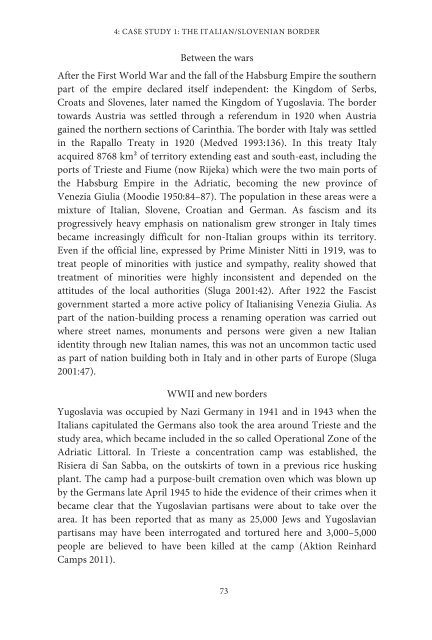1JZGauQ
1JZGauQ
1JZGauQ
You also want an ePaper? Increase the reach of your titles
YUMPU automatically turns print PDFs into web optimized ePapers that Google loves.
4: CASE STUDY 1: THE ITALIAN/SLOVENIAN BORDER<br />
Between the wars<br />
After the First World War and the fall of the Habsburg Empire the southern<br />
part of the empire declared itself independent: the Kingdom of Serbs,<br />
Croats and Slovenes, later named the Kingdom of Yugoslavia. The border<br />
towards Austria was settled through a referendum in 1920 when Austria<br />
gained the northern sections of Carinthia. The border with Italy was settled<br />
in the Rapallo Treaty in 1920 (Medved 1993:136). In this treaty Italy<br />
acquired 8768 km² of territory extending east and south-east, including the<br />
ports of Trieste and Fiume (now Rijeka) which were the two main ports of<br />
the Habsburg Empire in the Adriatic, becoming the new province of<br />
Venezia Giulia (Moodie 1950:84–87). The population in these areas were a<br />
mixture of Italian, Slovene, Croatian and German. As fascism and its<br />
progressively heavy emphasis on nationalism grew stronger in Italy times<br />
became increasingly difficult for non-Italian groups within its territory.<br />
Even if the official line, expressed by Prime Minister Nitti in 1919, was to<br />
treat people of minorities with justice and sympathy, reality showed that<br />
treatment of minorities were highly inconsistent and depended on the<br />
attitudes of the local authorities (Sluga 2001:42). After 1922 the Fascist<br />
government started a more active policy of Italianising Venezia Giulia. As<br />
part of the nation-building process a renaming operation was carried out<br />
where street names, monuments and persons were given a new Italian<br />
identity through new Italian names, this was not an uncommon tactic used<br />
as part of nation building both in Italy and in other parts of Europe (Sluga<br />
2001:47).<br />
WWII and new borders<br />
Yugoslavia was occupied by Nazi Germany in 1941 and in 1943 when the<br />
Italians capitulated the Germans also took the area around Trieste and the<br />
study area, which became included in the so called Operational Zone of the<br />
Adriatic Littoral. In Trieste a concentration camp was established, the<br />
Risiera di San Sabba, on the outskirts of town in a previous rice husking<br />
plant. The camp had a purpose-built cremation oven which was blown up<br />
by the Germans late April 1945 to hide the evidence of their crimes when it<br />
became clear that the Yugoslavian partisans were about to take over the<br />
area. It has been reported that as many as 25,000 Jews and Yugoslavian<br />
partisans may have been interrogated and tortured here and 3,000–5,000<br />
people are believed to have been killed at the camp (Aktion Reinhard<br />
Camps 2011).<br />
73




